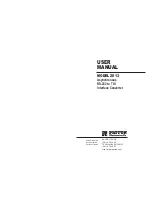
What’s MIDI?
WHAT'S MIDI?
Musical Instrument Digital Interface (MIDI) is a way for keyboards, synthesizers, sequencers, rhythm ma-
chines, and computers to communicate with each other. Devices that have a MIDI jack can be connected
together to send and receive information. Since most musical instrument manufacturers have agreed on MIDI,
you can connect devices of various manufacturers.
Each piece of information is called a MIDI MESSAGE. Each MlDI message is made up of 1 to 3 bytes (num-
bers); a Status Byte and 0, 1 or 2 Data Bytes.
The typical MlDI message is in the following form.
Sn. xx. yy
S
= Status (8-E)
n
= Channel number (0-F indicates channel 1-16)
xx = First data byte (00-7F)
yy = Second data byte (00-7F)
Let’s look at a sample 3-byte MIDI message.
For example, if a DX7 synthesizer receives this message, it does the following.
1.
Checks the channel number to see if it is acceptable. If the DX7 has been set to receive that channel, it
goes on to the next step. If not, the message is ignored. In the example above, the channel number is 4.
(We count 0-F as 1 to 16.)
2.
Checks the status. In this case, the status is Note On, so the DX7 knows to expect two more data bytes;
note number (what note) and velocity (how hard it was hit).
3.
Reads the data bytes and produces the correct note with the correct velocity. (Keep in mind that all this
takes a very short time. It takes about 1/1000 of a second to send a MlDI message. To us, it seems as
though sound is produced at the same time the key is pressed.)
Some MIDI messages have only two bytes; a status byte and a data byte.
For example,
C3. 05
is a Program Change message on channel 4, telling the receiving device to switch to program number 6.
MIDI messages with a status byte from F0 to FF have no channel number. They are called System Messages,
and are received by all devices regardless of their channel setting.
For an explanation of each type of message, see the MlDI Format Table on the next page.
–80–









































